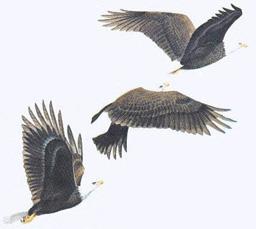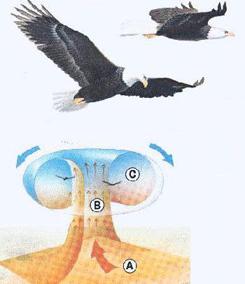The Bald Eagle's
Quest for Flight

Zoo Books Copyright © 1985 all rights reserved.
The Body of an eagle is made for flying and for catching prey. To do these things, the body must be light in weight and very strong. It must be light enough to get off the ground and fly high in the air, but strong enough to swoop down on prey and carry it away. To make their bodies lighter in weight, eagles have hollow bones. In some places, there are braces inside the bones to make them stronger (as shown above). But many parts of the bones have nothing
inside them them but air. As incredible as it may seem, the entire skeleton of a Bald eagle weighs only a little more than half a pound (272 grams).
 When an eagle flaps its wings, most of the power for flying comes from the downward stroke of the wings. For this reason, the muscles that pull the wings down are much larger than the muscles that pull the wings up. The flight muscles are so Important to an eagle that they often account for half of the bird's total weight.
When an eagle flaps its wings, most of the power for flying comes from the downward stroke of the wings. For this reason, the muscles that pull the wings down are much larger than the muscles that pull the wings up. The flight muscles are so Important to an eagle that they often account for half of the bird's total weight.

An eagle can fly faster or slower by changing the position of its wings. When It wants to fly fast, it turns the front edges of the wings into the wind and "cuts through" the air. When the eagle wants to slow itself down, it turns the wide surface of the wings into the wind, and the wings "drag" through the air. There is no room for a sloppy landing on top of a tall tree or on a cliff, so eagles have to be good at landing. To slow themselves for a landing, they spread their wings and tall down, and "drag" them through the air to act like brakes.
It is really amazing to see the many ways in which an eagle's body combines low weight with high strength. There doesn't seem to be an extra ounce of weight anywhere. For example, the feathers on a large eagle can be very sturdy but each feather weighs next to nothing. A Bald eagle has more than 7 thousand feathers, but all of them put together weighs less than 21 ounces (586 grams). If you took 30 of these feathers in your hand, they would weigh less than a penny.

The wings of eagles are powerful and eagles often use them with great skill. Eagles know how to climb high into the air without working too hard. They can swoop down on prey at incredible speeds. And once they have caught it, they can lift very heavy prey into the air. (Some eagles can even fly away with prey that weighs more than they do).
When an eagle first leaves the ground, it gains altitude by flapping its wings. The flapping motion causes air to flow faster over the top of the wings, and the bird rises.
Sometimes, an eagle is able to take advantage of natural currents of air to help
it rise. When wind runs into a hill or a mountain, it is forced upward - and the
eagle can go along for the ride. This kind of air current is called a slope updraft.

The wings of an eagle are a miricle in lightweight design. A female Bald eagle can have wings that are
almost 8 feet long (243 centimeters) - and yet, the wings weigh less than 2 pounds (900 grams). This is possible because the feathers are light and because they overlap, with lots of air spaces between them (as shown). Pound for pound, an eagle wing is stronger than a wing of an airplane. Most eagles have wings that are rather long and wide, to help them soar and glide with less effort. At low speeds, broad
wings can hold a bird up in the air longer than narrow wings. And broad wings provide extra lift when an eagle has to carry its prey up into the air. To rise really high into the air, eagles often hitch a ride on rising bubbles of hot air called "thermals." Once an eagle gets into a thermal, it can just spread its wings and float upward with very little effort.

Eagles are wonderful flyers, and they often seem to do their most spectacular tricks just for the fun of it. Some eagles can swoop through the air at incredible speeds as they dive. They may go as fast as 200 miles per hour (325 kiolometers). Other eagles turn over and over and over and sometimes lock their
claws together and spiral down for thousands of feet.
Scientists divide the feathers of an eagles wing into groups. Each group has a different role to play in
helping an eagle to fly.

"Green Feathers" Coverts make the wing thicker in front, so that air will flow faster over the top of wing.
"Grey Feathers" Primary feathers can be spread out like the fingers on a hand to reduce drag.
"Blue Feathers" Secondary feathers can be moved down to increase drag, or up to reduce it.

Eagle feathers can be incredibly strong. This is because each feather is held together by more than 350 thousand hooks. the picture here shows what a feather looks like when you look at it under a microscope. The part with hooks are called hook barbules (BARB-yulz), and the parts that they are hooked to are called bow barbules. Every part of the feather is made up of keratin, the same thing that your fingernails are made of.
Feathers are very important in the lives of all birds. They provide an outer covering for the bodies of the birds that helps keep them warm and waterproof, they assist in flight and make birds look beautiful in order to attract a mate to raise their young. Different kinds of feathers cover different parts of a bird. Flight feathers cover the wings and tail. They are long and wide, so they can cover a large area without adding much to the weight of the bird. Contour feathers cover the body. These are often the most colourful feathers. Down feathers grow under the contour feathers. When you look at a feather under a microscope, you can see that it is made of thousands of spines. These spines are called barbules. Normally, they are hooked together, and this makes the surface of the feather seem smooth. When a feather gets a lot of hard ware, the barbules may come apart. When this happens, the feathers start to look ragged and messy.
Back to Bald Eagle

Design by:

